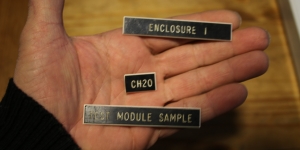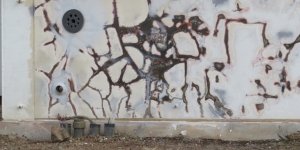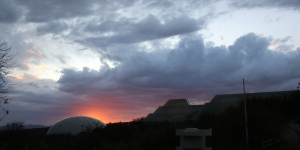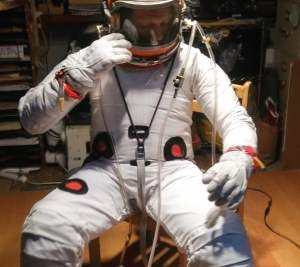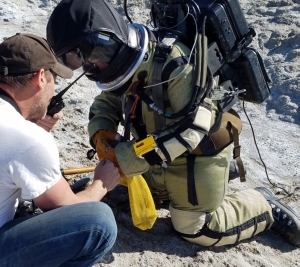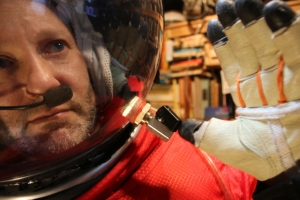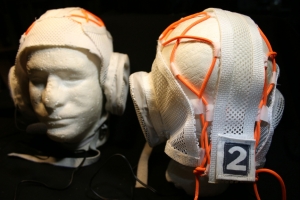The best thing about this project is that the Test Module is not a PowerPoint presentation. It is a real object. I am helping refurbish the structure, with long sessions of grinding or other manual work that is ideal for thinking alone, uninterrupted. Some results of that time and thought, in the following.
My mind first considers the time context of my surroundings. The Test Module is an artifact, a structure generated by the minds and then hands of people. I imagine them here, originally, blurs moving about the gravitational center of this structure. I wander through what Thomas Carlyle (1795-1881) called the ‘billows of time’, writing in 1860:
“Rough Samuel and sleek wheedling James were and are not. Their Life and whole personal Environment has melted into air. The Mitre Tavern still stands in Fleet Street; but where now is its scot-and-lot paying, beef-and-ale loving, cocked-hatted, pot-bellied Landlord; its rosy-faced, assiduous Landlady, with all her shining brasspans, waxed tables, well-filled larder-shelves; her cooks, and bootjacks, and errand-boys, and watery-mouthed hangers-on? Gone! Gone!…The Bottles they drank out of are all broken, the Chairs they sat on all rotted and burnt ; the very Knives and Forks they ate with have rusted to the heart, and become brown oxide of iron, and mingled with the indiscriminate clay. All, all, has vanished…[yet]…the mysterious River of Existence rushes on: a new Billow thereof has arrived, and lashes wildly as ever round the old embankments; but the former Billow, with its loud, mad eddyings, where is it?”
From page 88 of Carlyle, T. 1860. Critical and Miscellaneous Essays (III). Boston, Brown and Taggard.
We’re the most recent of these billows, Kai, Trent, and myself. We rush around hammering and sawing, painting, hoovering, hauling. Our efforts will bring some new function to this shapely structure. The results will carry on beyond us, digitized as scientific findings. Our small piece of the vast puzzle of human knowledge will be set in place.
The glass, metal, plastics and other materials composing the structure were brought together decades ago. From minds, to lines on paper, to materials brought together, to assembly. As with all fabrication it can seem like a slow form of magic. But it is not supernatural. Science outlines the relationships of things without invoking supernature, attributed causes to natural phenomena, and allowed us little humans to move and assemble an infinite array of materials for our various purposes. Today we move individual atoms, we control the flow of electrons; we are learning to manipulate remotely-entangled quantum particles. By less-subtle but still effective matter- and energy-manipulating means, the Test Module was constructed in 1987, enclosing just over 400 cubic meters in a sealable environment. It would be used to better understand the workings of living systems by the method of sequestering them from the rest of living systems.
 These purposes were presented in Biological Life Support Technologies: Commercial Opportunities, NASA Biosphere 2 test module experimentation program by Alling, A., L.S. Leigh, T. MacCallum and N. Alvarez. 1990.
These purposes were presented in Biological Life Support Technologies: Commercial Opportunities, NASA Biosphere 2 test module experimentation program by Alling, A., L.S. Leigh, T. MacCallum and N. Alvarez. 1990.
The structure was used, useful quanta were generated and then attention turned to the larger Biosphere, and the Test Module languished. It took on dust. Paint cracked and flaked away with gusts of wind. A window’s exterior pane was shattered by a pebble flung up by a weed-eater. Spots of rust wept orange streaks down the white exterior.
But after decades of this anonymity, attention returned to the Test Module. It still stood. Kai Staats, decades in the worlds of high power computing, radio astronomy and various fields of invention turned his energies to the research potential of the Biosphere. Deputy director John Adams pointed out that the Test Module remained viable. It needed work, but the essential structure was intact. In the nation and the world, the last decade had seen a new ‘billow’ of form shaping; serious thought was again entertained about the possibilities of humans living beyond the surface of the Earth. This can only be done if we come to understand the ecology of closed environments. Kai had built SIMOC, a computer model of a closed ecosystem now using the power of distributed computing to simulate complex habitats. The Test Module, thought Kai, could be the material analog of SIMOC, eventually informing, improving the fidelity of the datasets. And here we are.
We pull and pry old objects from the Test Module. White on black monitor labels “SAMPLE”. Grinding paint from a steel bulkhead, strangely familiar shapes appear before me. They remind me of Percival Lowell’s certain discovery of canals on Mars. We keep grinding and then paint and eventually these billows also melt away. When we complete a task we whoop and holler aloud. It’s fun and it feels good to walk up to our quarters to make dinner; tonight, spaghetti with a cold beer. One sunset the air was full of moisture, glowing.
The form of the Test Module is structured by engineering paradigms of Buckminster Fuller (1895-1983), who was – among so much more – fascinated with the concept and realization of efficient enclosures. Again I bump up against a billow in time, I was taken to meet Fuller at my father’s university in the early 1980’s, then he was carried off to his world and I to mine and here I am back in manifestations of his mind.
Next to being real, and not a PowerPoint, the best thing I can think of the Test Module and its associated SAM project and the Biosphere project at large is the goodwill. These are things manifested from the mindset that all humanity can benefit from science and the imagination that it can ignite. I wonder what visitors to the larger Biosphere 2 structure think of the project. Sometimes I thank them for taking a little while to imagine something else, other possibilities. There are other ways to be, we can imagine them, sometimes we build models of them, sometimes we manage to live them. Only the coldest cynic or the most disinterested person could wonder at the use of such giant ideals manifest.
Another part of my being here; space suits. For the last decade, after my work as a prehistorian at Portland State Univeristy’s Department of Anthropology, I have been engaged in designing, building and testing a variety of pressurized garments; bubbles of ‘livingry’ that could allow humans to survive, for example, on Mars. We test them at altitudes, flying balloons, helicopters, fixed-wing aircraft…whatever will get us off the surface of Earth and testing things in the real world. They are working; they hold pressure, maintain acceptable temperature and CO2 levels, and allow the mobility needed for their various purposes. A single suit takes some months to complete. Now I come to build some suits of this kind for SAM. The challenges are invigorating. They must be durable, washable, easily-repaired, with few complexities; like an old farm pickup truck, nothing exotic, but entirely reliable and eminently refurbishable. I’ll work to maintain these features for the SAM suits. I think about them as I sand the steel bulkhead. Circular motions. Can I improve sleeve fit adjustment straps? Did I ever follow up on that new snap-link closure? How often will these be used in a given SAM simulation day? I need to write instructions on how to clean with detergent and then dry them. I keep sanding. The answers are jotted down in my pocket notepad. The sky flares orange and we head back up the hill for dinner.


